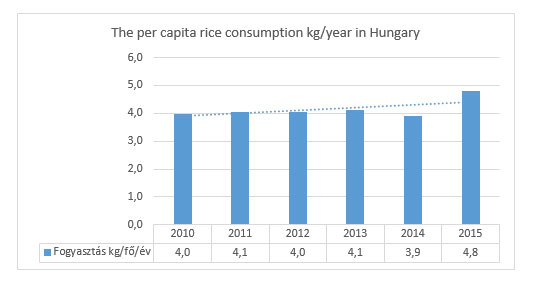Contents
Rice division
Role
The rice import and distribution was present among the activities from the very beginning of the foundation of the Company. Beside the other foodstuff export, import and distribution of rice represents a growing share from the T/O of the Company over the time. Nowadays rice business is the flagship of the Estraco kft.
The rice range
First price products with GFP brand

„A” quality – 1 kg
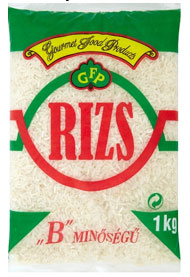
„B” quality – 1 kg

Parboiled – 1kg
First price products with ALOS brand
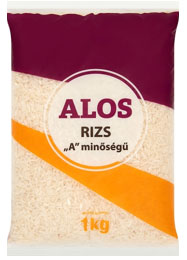
„A” quality – 1 kg
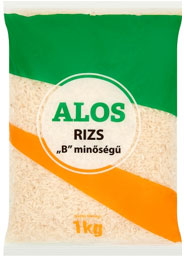
„B” quality – 1 kg
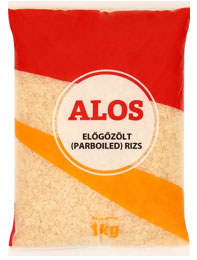
Parboiled – 1 kg
GFP premium range


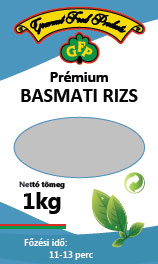
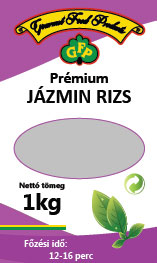

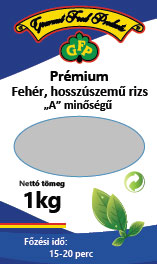
Special products
- Organic rice
- Organic rice flour
Import and distribution
The lots imported by Estraco is not only distributed under the Company’s own brands GFP and Alos but sold to various buyers in Hungary who after packaging and processing the lots imported by Estraco distributing the products under producers’ or traders’ brands for human or industrial purposes.
The most searched for type of rice in the import portfolio are as follows:
- Long Grain White Rice
- Medium Grain Rice
- Parboiled Rice
- Cargo/Brown Rice
- Jasmine Rice
- Basmati Rice
- Risotto Rice
Export
Rice export started back in 2014 and it covers wild rice and organic rice export to different markets in Europe.
The history of rice
Rice was introduced in Greece following Alexander the Great’s expedition to Asia, as far as the banks of the Indus, in about 320 B.C. The Arabs introduced rice in the south of the Iberian Peninsula in the eighth century A.D. Rice was then a rare foodstuff, reserved for royal tables. There is evidence of rice growing in Portugal in the thirteenth century and it was re-launched by the Portuguese navigators after the opening of the route to the Indies in the late fifteenth century. Rice doubtless spread to Italy from Portugal, first in the Kingdom of Naples and then in the plains of the river Po, where the crop became definitively established. With the succession of generations, each region has developed its own rice culinary specialities: riz au gras in the Camargue, the many Milan-style risottos in Italy, and the paella Valenciana in Spain, etc. Rice has thus participated in the economic development of initially very underprivileged zones and in the emergence of social and cultural traditions that contribute to the reputation of these regions today.
European rice-growing areas resulted from the drainage of regions long considered as being unhealthy and inhospitable (the deltas of major rivers and alluvial plains) but that had abundant water resources. Rice was introduced, after substantial development work, as a “pioneer” crop that leaches the soil, making it suitable for other crops (grapevines and grain crops). Today, rice cropping plays an important role in the maintenance of ecological equilibrium and biological richness of these fragile ecosystems.
Major types
Four major types of rice are produced worldwide:
- Indica is grown mostly in tropical and subtropical regions and accounts for more than 75 percent of global trade. Indica rice cooks dry, with separate grains.
- Japonica rice, typically grown in regions with cooler climates, accounts for more than 10 percent of global rice trade.
- Aromatic rice, primarily jasmine from Thailand and basmati from India and Pakistan, accounts for more than 10 percent of global trade and typically sells at a premium in world markets.
- Glutinous rice, grown mostly in Southeast Asia and used in desserts and ceremonial dishes, accounts for most of the remainder.
Rice processing
The first step is the threshing and shelling, where the kernel is still covered by hard, outer hull. The kernel is still suitable for planting. However it is not suitable for cooking and consumption.
The second step is cargo rice. Cargo or Brown rice also comes in long, medium and short variety. The main difference from white rice is that the rice germ rizs csíra and bran layer korpa (ezüst hártya) réteg remain on the rice kernel, with only outer hull külső burkolat, héj removed. Brown rice is 100% whole grain and widely considered healthier than white rice. It has slightly chewy texture and nutty flavour.
The result of further procession of the cargo (brown) rice is white rice. After removing the impurity mixtures, the rice is classified by length and width and with the polishing process the bran is also removed.
Quality and consumer demand
The main components of rice quality have been defined by the EU “Regulation on the common organisation of the market in rice” (Council regulation No. 1785/2003). Quality components are mainly related to the shape, colour, and integrity of the grain. Other important components are milling quality, cooking and processing behaviour and grain fissuring. The regulation distinguishes four categories, based on grain length (L) and length/width (L/W) ratio: Long A: L >6.0 mm, L/W<2.1–3.0; Long B: L >6.0, L/W = 3.0; Medium: L>5.2, L/W<3.0; Short: L <5.2, L/W <2.0.
Rice varieties grown in Europe mostly belong to the japonica group, initially associated with round to medium-long grains that readily become sticky when cooked. Local specialty varieties are highly appreciated in local markets, especially when they are associated with an Appellation of Protected Origin emphasizing their local origin and the environment-friendly specification of the cropping practices. However, demand for long Indica - type grain, for exotic specialty rice such as Basmati and Jasmine rice, and for organic rice is rapidly growing with the increase in rice consumption in Europe, 6% per year.
Rice producing countries, consumptions
World
Rice producing countries
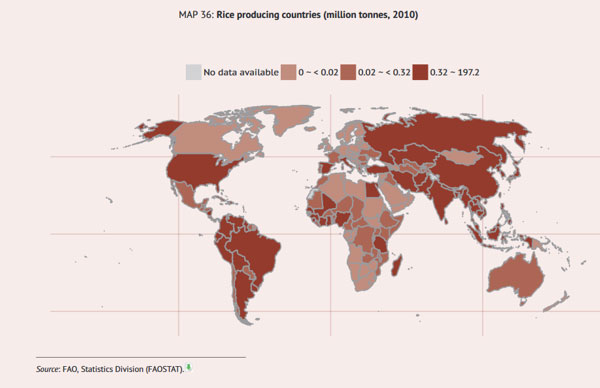
Rice consumption per capita in Asia and in the World
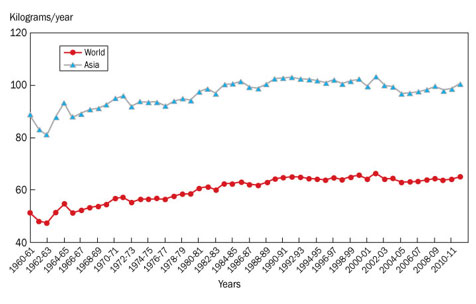
The total global rice consumption is growing continuously half of which are given by China and India.
Europe
Though neither a staple food nor a major crop in Europe, rice has an important sociocultural significance and ecological importance in several Mediterranean countries of Europe. Per capita annual consumption ranges from 3.5 to 5.5 kg of milled rice in no rice-growing countries of northern Europe to 6–18 kg in southern Europe. The total rice-growing area within the 28 European Union (EU) member countries is about 450.000 ha, the average annual production about 3.1 million tons of paddy rice, and average annual rice imports about 1.1 million tons. EU self-sufficiency in rice is about 70%. Some 80% of EU rice production takes place in Italy and Spain, with a further 12% in Greece and Portugal. The remainder comes from four other countries: France, Romania, Bulgaria, and Hungary. Outside the EU, rice is also grown in the Russian Federation (120,000 ha in the Krasnodar region and 50,000 ha in the Far East region of Vladivostok) and in Ukraine (25,000 ha).
Consumers' intentions to increase rice consumption in the near future will be significantly associated with perceptions regarding four attributes of rice: good taste, healthfulness, low calorie content and specialty
Source: Ricepedia 2015
Hungary
The rice was introduced in Hungary during the Turkish occupation in the XVI. Century. After the Turkish occupation back in the middle of 1700, Italian settlers started the rice cultivation in the southeastern part of Hungary and it was restarted on 1880 in the Bácska region.
The researches and experiments in connection with the rice started in 1933 in Szeged and the mass production theory was worked out at that time as well. Between1950-1970 rice was grown in 50.000 ha in Hungary, which started to decrease gradually from 1970.
In 2004 when Hungary joined the EU according to the agreement EU is substituting rice production in 3222 ha. Today the rice cultivated area is around 3000 ha. The production of this area is covering 20% of the total demand of Hungary.
Rice production is concentrated in the following areas. Békés, Csárdaszállás és Köröstarcsa, Gyomaendrőd, Szarvas, Mezőtúr, Kisújszállás.
The rice cultivation area and production in Hungary

The per capita rice consumption in Hungary
